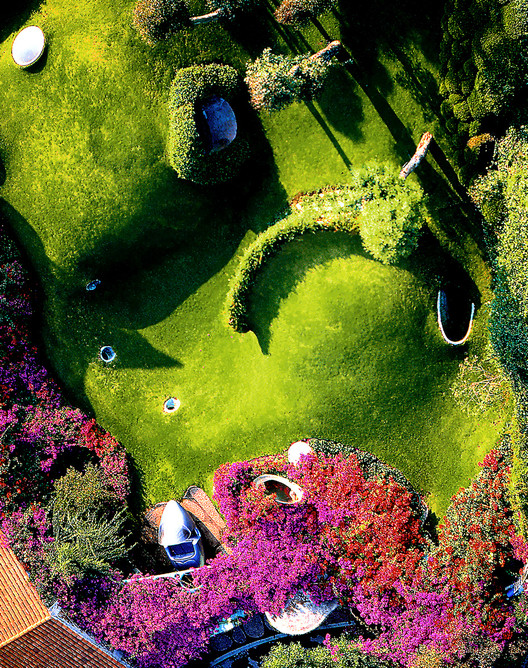Temporary Shelter in Nepal Charles Lai + Takehiko Suzuki
2015-07-13 20:00
Courtesy of Charles Lai, Takehiko Suzuki
铃木幸彦赖礼


架构师提供的文本描述。香港的赖先生和东京的铃木太彦,连同香港的实践工作室(中性建筑工作室),完成了一个在尼泊尔为地震灾民建造的快速避风塘的原型,里面有竹竿和其他当地可用的材料。这两位建筑师于2015年4月发起了一个建筑救济组织“弥撒建筑”,以应对尼泊尔地震。
Text description provided by the architects. Charles Lai from Hong Kong and Takehiko Suzuki from Tokyo, together with Hong Kong based practice aona (atelier of neutral architecture), completed a prototype for a rapid erected shelter for earthquake victims in Nepal with bamboo poles and other locally available materials. The two architects initiated an architectural relief organization, Architecture for the Mass, in April 2015 in response to the Nepal Earthquake.
Courtesy of Charles Lai, Takehiko Suzuki
铃木幸彦赖礼


尼泊尔救灾机构面临的障碍之一是,穿越这个多山国家的运输存在巨大困难。许多路面没有铺好路面,对于载重的卡车来说太窄了。因此,即使帐篷和帆布等紧急救济物资可以乘坐货机进入尼泊尔,这些物资也很难扩散到偏远的村庄。因此,许多失去家园的家庭自行建造了临时住所。但显然,它的结构是脆弱的,没有适当的地板和墙壁的空间是不舒服的。他们使用的泥砖没有抗震能力,而且由于它的重量而危险。当季风季节来临时,大雨很容易进入室内。
One of the obstacles faced by disaster relief agencies in Nepal is that transportations across the mountainous country are of tremendous difficulties. Many of the road surfaces were not paved properly and were too narrow for trucks with heavy loads. As a result, even though emergency relief materials such as tents and canvas could be flew into Nepal by cargo planes, these materials can hardly proliferate into the remote villages. As a result, many families who lost their home have built temporary shelters by themselves. But apparently its structure is fragile and the space is uncomfortable without proper floors and walls. Mud bricks they use are not earthquake resistant, and dangerous because of its weight. When the monsoon season comes, the heavy rain water can easily come inside.
Courtesy of Charles Lai, Takehiko Suzuki
铃木幸彦赖礼


对此,Charles和Takehiko设计了一套竹制框架结构,可以使庇护所更加舒适和高效地用尼泊尔村庄当地可用的材料建造。竹子在这个地区是一种廉价而丰富的材料,也很容易运输、切割和组装。结合简单的连接细节,非熟练工人可以在2-3天内组装庇护所。建筑师们编写了一本建筑手册,说明了竹结构框架的组装方法。该手册可以在没有建筑专业人员的情况下通过因特网传送到各地区。当地可以简单地按照手册将竹框组装成临时建筑,这些建筑具有各种功能,如庇护所、托儿所、诊所、社区中心等。没有建筑专业人士的帮助。
In response to that, Charles and Takehiko designed a system of bamboo frame structure that could allow shelters to be more comfortable and erected efficiently with materials that are available locally in the villages of Nepal. Bamboo is a cheap and abundant material in the area, also quite easy to deliver, cut, and assemble. Together with the simple connection details, unskilled workers can assemble the shelter within 2-3 days. The architects prepared a construction manual that illustrated the assembly methods of the bamboo structural frames. The manual could be transferred through the Internet into regions without construction professionals. The local could simply follow the manual and assemble the bamboo frames into temporary buildings of various functions, such as shelter, nursery, clinic, community center, etc. without the help from construction professionals.
Floor Plan


Courtesy of Charles Lai, Takehiko Suzuki
铃木幸彦赖礼




为准备季风季节的降雨,框架的剖面由一个凸起的平台和一个倾斜的屋顶设计组成,以保持室内干燥。对角线单元为框架提供了刚度,提高了结构的抗震能力。根据建筑材料的可用性,可以使用金属片、帆布或竹子条来构造结构的外壳。该原型是与香港的一个村重点基金合作在杜瓦科特村建造的。一个由10名志愿者和4名付费工人组成的团队在两天内完成了原型的建造。来自受损房屋的木材和金属板被重新用于建造掩蔽所的封套。300万×600万住房的费用约为400-500美元。竹材结构框架可根据结构的功能分为不同的尺寸。Charles和Takehiko预计原型将为尼泊尔的临时庇护所提供替代解决方案。当地可以吸收原型的设计,并根据其原理进行进化设计。其目的是向普通家庭提供建立自己的临时结构的工具和方法。潜在的,该设计可以使当地社区建立一个自助网络,并加快灾后的恢复。
To prepare for the rain during the monsoon season, the sectional profile of the frames consists of a raised platform and a pitched roof design to keep the interior dry. The diagonal elements provide rigidity to the frame and improve the quake resistant ability of the structure. Depending on the availability of building materials, metal sheets, canvas, or bamboo strips could be used to construct the envelope of the structure. The prototype was built in the village of Duwakot in collaboration with One Village Focus Fund in Hong Kong. A team of 10 volunteers and 4 paid workers constructed the prototype in 2 days. Timber and metal sheets from the damaged houses were reused to construct the envelope of the shelter. The cost of the 3m x 6m shelter is around US$400 -$ 500. The bamboo structural frame could be appropriated into different sizes depending on the function of the structure. Charles and Takehiko anticipate the prototype to provide an alternative solution for temporary shelters in Nepal. The local can assimilate the design of the prototype and produce evolved designs based on its principle. The aim is to equip general households with the tools and methods to erect their own temporary structures. Potentially, the design can empower the local community to establish a self-help network among themselves and speedup the recovery from the disaster.
Courtesy of Charles Lai, Takehiko Suzuki
铃木幸彦赖礼


在临时结构原型的开发和建造之后,大众建筑将侧重于重建Gorkha、Katunge和Bhaktabur地区严重受损地区的学校和社区设施。(空运由Expedia香港赞助)
After the development and construction of the temporary structure prototype, Architecture for the mass will focus on reconstruction of schools and community facilities in severely damages regions of Gorkha, Katunge and Bhaktapur regions. (Air transportation is sponsored by Expedia Hong Kong)


Courtesy of Charles Lai, Takehiko Suzuki
铃木幸彦赖礼


.jpg)









































.jpg)



.jpg)

.jpg)

Architects Charles Lai, Takehiko Suzuki
Location Duwakot, Nepal
Category Small Scale
Design Team Eric Ng, Gigi Lee, Timothy Lam, Yorkun Ho (Architecture for the Mass), Hari, Bibek, Sujan, Dinesh, Sudip, Prabhakar, Bibhuti, Laxman, Binay (Nepal local team), Samantha Tang, Lai Pui Tung, Ho Fung Lun
Area 18.0 sqm
Project Year 2015
























